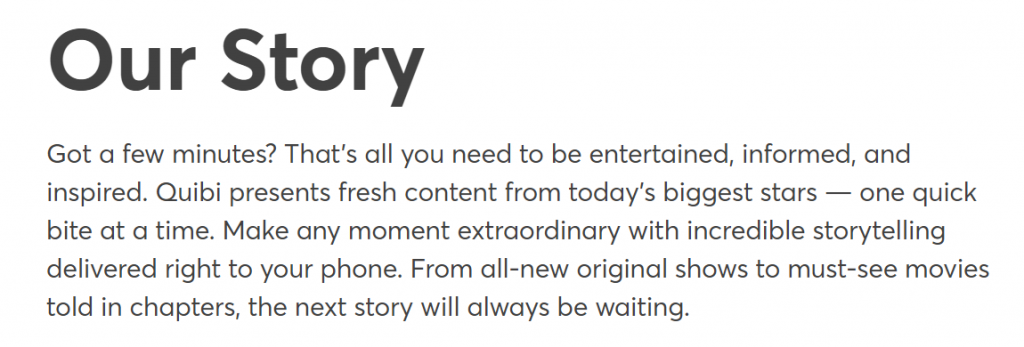A few days ago I stumbled upon the shut down message of a business I had never heard of before – Quibi. Quibi was trying to create a streaming platform with self-produced content and licensed movies in short episodes, all with the idea in mind to be mobile-first.

Some quick background bites
The startup had good reasons to be confident about its future. The two founders are Jeffrey Katzenberg and Meg Whitman, two heavyweights in the Hollywood and platform industries. Katzenberg had been head of Walt Disney Studios and builder of DreamWorks before, his net worth equals nearly $900 million. Whitman, as well, is a Disney and DreamWorks veteran, has been CEO of eBay for 10 years and and was voted into the Time 100 in 2014. Leveraging their powerful (and probably trustworthy) position in the media industry, they acquired supporters such as Jennifer Lopez, LeBron James, Chance the Rapper, Idris Elba, Bill Murray, Steven Spielberg and Chrissy Teigen for Quibi, as The New York Times is reporting. They also sold out their $150 million first-year advertising inventory as planned. All while raising $1.8 billion funding from some of the largest media and entertainment companies out there, among them BBC Studios.
Even with almost $1.8 billion to their name they fucked it up. Think about it. 1.8 billion. So, for anybody out there wondering just as me, if your life as a YouTube channel would be better with more money and more power, we have now official proof that money and power do not solve all your problems in today’s media landscape.
Fun fact because we are here over on HollyWhat?:
In 2018, Meg Whitman found herself a West Hollywood condo for $6.5 million with an oceanview in the same building that once Elton John and Cher called their adress. Meanwhile, Jeffrey Katzenberg’s just sold his Beverly Hills mansion for $125 million, which is reported to be the third-highest real estate sale in Californian history 🙂
In an open letter they reminisced about the reasons they had to stop their business. Eventually, they narrowed it down to two points:
“because the idea itself wasn’t strong enough to justify a standalone streaming service or because of [the] timing.”
This is a really shallow observation in my eyes, so I went to have a closer look on the issue. I was able to identify three hands-on lessons to learn.
1) Make Sure to Test Your Service Early
For me it would be frankly unbelievable that such experienced outstanding executives would bet so wrongly on an idea, if it wasn’t in media. Quibi seems to be a case in point of an observation made by Picard:
“[M]any decisions in media industries are based on noneconomic criteria and rely upon public service, artistic, and cultural factors, established relationships, the intuition of creative decision makers, and—sometimes—whimsy and hubris”
Picard, 2005, p. 65
I’m not saying that economic criteria and extensive strategic planning is always better than creative intuition, but in management we also know of a thing called The Lean Start-Up (you can read about it here). Following the lean start-up method Quibi would’ve chosen real customer feedback over intuition. It would’ve experimented with a beta-version of their service before starting to plan with 7 million paying subscribers in the first year. And Quibi wouldn’t have endorsed big expenses up front, for which it would have avoided the film production costs of up to $100,000 per minute which it eventually faced. Since Quibi envisioned to live off 10-minute episodes, this amounts to up to $1 million of costs per episode. It’s obvious that both, Katzenberg and Whitman, probably got their hubris from their impressive track records. They should’ve tested assumptions they made.
Edit: After publishing this post I found out about this article in HBR from August 2018. It’s by the same author that published “Why the Lean Start-Up Changes Everything” in January the same year. The piece, curiously enough, actually uses Quibi (back then still being named “NewTV”) as a case study to sketch out in which circumstances there might be better strategies than The Lean Startup. Turns out, the author was too quick to question his own method.
2) Even Hollywood Content Doesn’t Necessarily Make You Rich When Nobody Wants to Pay
What else went wrong? If you plan to invest into high quality content, you should make sure that somebody pays you for that. Quibi favored to rely on content with A-list celebrities serving as actors and producers to make up for the fact that they didn’t have any well-known movies or series in their library. By focussing on famous stars they were hoping to raise the bets to land a hit. This, in essence, is a clever strategy that has worked out over decades. It is also a feasible approach to navigate new consumers to the niche content of your library, as said by Chris Anderson, author of the Long Tail book. In addition, they placed commercials at the Super Bowl and the Oscars. Still, Quibi experienced problems to draw attention to their brand. Just as me (to be fair I’m European), 68% of the respondents from a poll by The Hollywood Reporter said they didn’t know the service.
Unfortunately, A-list celebrity content is frickin expensive. And Super Bowl airtime too. Aside: Quibi’s competitors spent way more on advertising in the first quarter of 2020 than Quibi. Such high costs are even trickier in an industry where we can frequently observe the 80/20 principle; 20% of the content/productions drive 80% of the sales. In turn, 80% are “misses” and share 20% of the revenues. This pile of “misses” is feasible to supply when production costs are low because then hit content can make up for it, but is this the case for Quibi with costs of up to $100,000/minute? Rather not.
What Quibi terribly miscalculated: the willingness to pay of video consumers. They were planning to charge $5/month for subscriptions including ads and $8/month for ad-free subs. A free plan was never an option. This is problematic in a world where first, people are subscribed to other streaming services already and second, have a mighty free catalogue on YouTube on hand. But it’s not something new. Chris Anderson, when he first came out with his long tail theory in 2004, as well noted:
“Cut the price in half. Now lower it.”
He even suggests that hits should be more expensive than the tail content (a differentiation we most commonly see in ticket prices already).
Quibi at least offered 90 days for free after its launch and managed to attract 1.3 million active users. However, only 500,000 (less than 50%) of them went for the paid subscription afterwards. 7 million were prospected within 10 months. Ultimately, even supposed hit content is no guarantee for revenue.
3) Find the Right Content Length
Furthermore, experts criticize that such short content episodes of 10 minutes belong to TikTok, YouTube, Facebook, and Instagram, not by design, but because there user-generated content is prominent. Other platforms such as Amazon Prime and Netflix that don’t use/allow user-generated content offer high-production content but in longer portions, where users can immerse themselves. Also, just for the record, we are in the middle of a pandemic, so many observers of the Quibi case believe that people now primarily use TV screens for content consumption and have time for longer clips because they just stay home and don’t try to bridge actions as they normally would in their working week.
We were wondering, if the assumption that professional content should be long and only user-generated content should be short would hold true for music channels. In fact, data from our own database including over 10,000 YouTube videos of music performances supports this theory. Here’s an overview of our analysis:
If we sort by video length, we can see that there are clear differences in popularity measures between shorter content and longer content. Videos of 5 to 10 minutes (Quibi’s range) gained only ~149,000 views on average and 1,700 likes as opposed to slightly longer content of 10 to 15 minutes which on average acquired 4.5 times more (685,000) views and almost 6 times more (10,100) likes.
| Length | Average Likes | Average Views |
| <5 min | 762 | 78,494 |
| 5-10 min | 1,739 | 149,331 |
| 10-15 min | 10,115 | 685,194 |
| 15-30 min | 6,212 | 391,969 |
| 30-60 min | 2,056 | 211,031 |
| 60-90 min | 3,125 | 300,580 |
| 90-120 min | 5,557 | 534,177 |
Considering likes, these video lengths rank best:
- 10-15 min
- 15-30 min
- 90-120 min
Considering views, these video lengths rank best:
- 10-15 min
- 90-120 min
- 15-30 min
If we combine both insights it seems wisest to create content of about 10 to 15 minutes length (if it suits your topic, of course), but also mid-length content of 15 to 30 minutes can be popular, as well as movie-length content of over 90 minutes. Certainly, don’t opt for under 10 minutes as Quibi did and try to avoid 30-90 min length, if possible.
We also took a look into the video length highly popular and unpopular videos have:
| Likes | Median Length |
| >100K | 00:20:26 |
| >50K | 00:18:36 |
| >10K | 00:20:00 |
| <5K | 00:34:35 |
| <2K | 00:34:01 |
| <1K | 00:32:32 |
| <500 | 00:28:59 |
| <50 | 00:14:25 |
Videos with more likes have a median length of 19 to 20 minutes while videos with little likes are either approximately 5 minutes shorter or up to 14 minutes longer. Longer is, however, still better than shorter.
| Views | Median Length |
| >10M | 00:38:58 |
| >1M | 00:23:17 |
| >500K | 00:36:55 |
| <100K | 00:24:11 |
| <10K | 00:05:50 |
| <1K | 00:04:46 |
Regarding views, the picture looks a bit deviant. Videos with more than 10 million views tend to be considerably longer than 20 minutes. 39 minutes, to be exact. One explanation is that YouTube favours them in its algorithm, so they get clicked more often, which, however, doesn’t tell us much about the viewer satisfaction. Anyhow, if you’re up for attention, this insight might still be useful. Videos with less than 1K views have a median length of under 5 minutes, which further supports our first data and again suggests to stay away from very short (quick) bites.
Final Thoughts
In summary, we’ve broken down what happened to Quibi into three key takeaways that will be helpful for channel managers. First, test your product/service early. If you want to believe in The Lean Startup Method, it would mean to create a minimum viable product and optimise incrementally from there. Second, don’t rely too much on A-list stars in your content. Neither did it make Quibi famous, nor did it backup their subscription fees. It might still attract (new) viewers, but make sure to not overspend then. And certainly don’t overspend on niche content either. It’s really hard to generate income with onlince services. Third, figure out what the optimal content length for your topic/format is. Music performances seem to work best when they’re 10 to 15 minutes long, for example. Episodes of 10 minutes were probably too short for Quibi and they might also be too short for music channels (aside from music videos, of course).
Readings/References
Picard, R. G. (2005). Unique Characteristics and Business Dynamics of Media Products. Journal of Media Business Studies, 2(2), 61–69. https://doi.org/10.1080/16522354.2005.11073433
